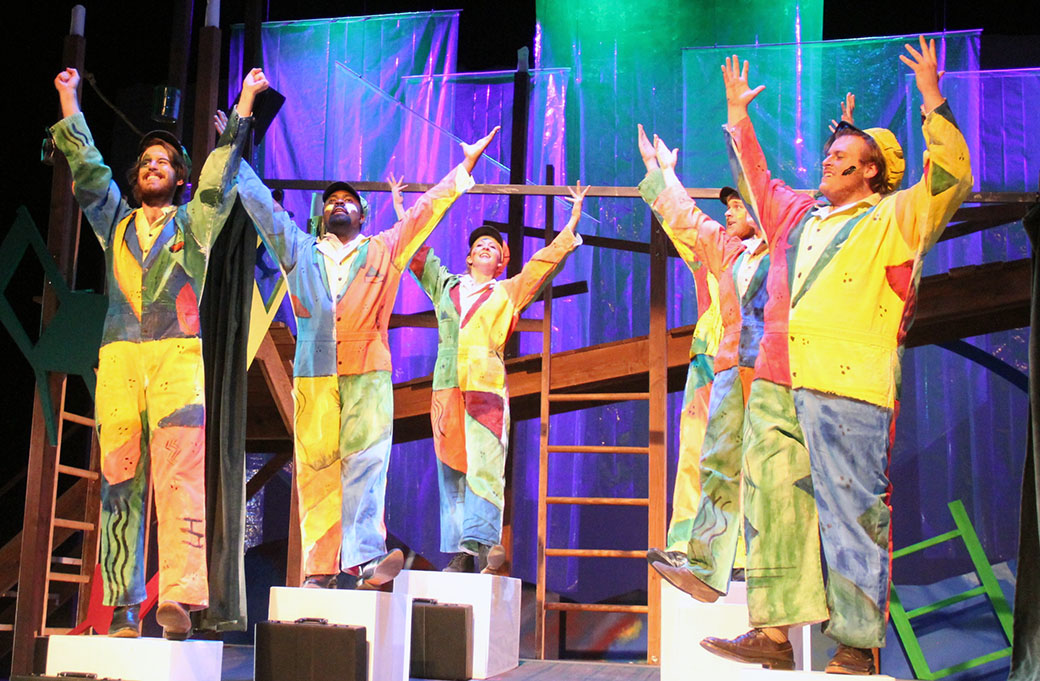
‘Green Violin’ showcases Jewish art, Yiddish culture
Green Violins, a campus-wide celebration of Yiddish art, culture and history, hosted various events starting in February and will end in May.
buy grifulvin online https://www.conci.com/wp-content/languages/new/online/grifulvin.html no prescription
One of these events was the “The Green Violin,” a musical representing Yiddish culture presented by USD Theatre from April 19 to April 23.
Representing Yiddish culture
“The Green Violin” follows the friendship and collaboration between famous 20th-century painter Marc Chagall and the Goset Theater, a state-sponsored Yiddish theater in Moscow launched in 1920.
Chagall is known for being the artist that helped shaped Yiddish culture. The play follows his relationship with Solomon Mikhoels, the Goset Theater’s lead actor.
Chaya Gordon-Bland, associate professor of theater and director of the play, said the production focuses on Jewish art.
“We have the artwork of Marc Chagall (for the) visual arts and we have the Goset theater creating their theatrical arts,” Gordon-Bland said. “We also have the play itself as a piece of Yiddish art that is theater, it is music. This is a very unusual musical in the sense that the style of music is klezmer.”
Preparation
Senior Lauren Stacks, a musical theater major who plays a member of the Goset Theater, said the theater department prepared a lot for “The Green Violin.”
“A lot of our work went into the structure of the music that the musical is based on… klezmer music, Yiddish language, Jewish prayer and ecstasy, post-impressionistic modern art, a speciality on the Chagall’s, a specialty in the Goset company (and) the Mikhoels,” Stacks said.
A lot of research went into USD’s production, Stacks said.
“We had this huge collection of research questions after reading through the script, after reading through the materials and collaborating with the researchers,” she said. “I actually got to paint a lot of the set that you see.”
The production brought in academia and other people from the arts, Stacks said.
“Our green violinist is a professor here. She teaches violin and we got to hear her story. She comes from a country torn by war and revolution,” Stacks said. “It was heart-wrenching and breathtaking and having that experience that show gives (brings) it a whole new level.”
A visit from the creators
Creators of “The Green Violin,” Elise Thorton and Frank London, visited USD’s campus last Thursday.
Gordon-Bland said she met with playwright Thorton in New York last spring to share resources. Gordon-Bland also contacted London, a Grammy Award-winning composer.
“(Elise and Frank joined) the rest of the artistic team to provide a talkback with the audience about the work and the process… the general public gets to benefit from having these phenomenal artists on our campus and then our students get some more face-to-face interaction and learning experiences from them,” Gordon-Bland said.
Gordon-Bland said it was overwhelming seeing the creators attend the play.
“It was a little stressful because we had this big creative work that you’ve been developing and you’re finally revealing to the public,” Gordon-Bland said. “In this case it’s much more exciting than stressful because I’m extremely proud of everyone’s work and I think we have a solid show.”
Gordon-Bland said performing “The Green Violin” was a “really big deal.”
“’The Green Violin’ is a very young play… there have been very few American productions,” Gordon-Bland said. “We say it’s a regional premiere, but it’s actually bigger than a regional premiere. It’s one of the first outside of the east coast and New England.”
A story that resonates
Ebrin Stanley, a senior musical theater major who played Abram Efros, an art critic, said “The Green Violin” was rewarding to be a part of.
“Being that it’s a new works, it was a huge creative and vulnerable process — deep discussions, research, laughter, tears and a lot of hard work,” he said. “This was a show that was about a real story and that means so much to a Jewish community. Getting to tell a story in the special way we got to tell it was amazing.”
Stanley said he was able to learn more about Yiddish culture.
“Song and dance is a huge part of Yiddish culture,” he said. “Getting to learn how they listen to music, the music they choose to listen to and how laughter and love always comes back to the forefront of their life, no matter the tragedy, has been such a rewarding and beautiful part of the whole experience.”
Gordon-Bland said the play’s story holds a connection to the political climate now.
“The story of people being subjugated, oppressed, disenfranchised and left out, unfortunately, is a story as old as time. It is a story that I feel that resonates with our current political times,” Gordon-Bland said. “I think there is a very subversive element of making the choice to be compassionate, loving, to appreciate, recognize goodness, light and miracles even when things are difficult.”

